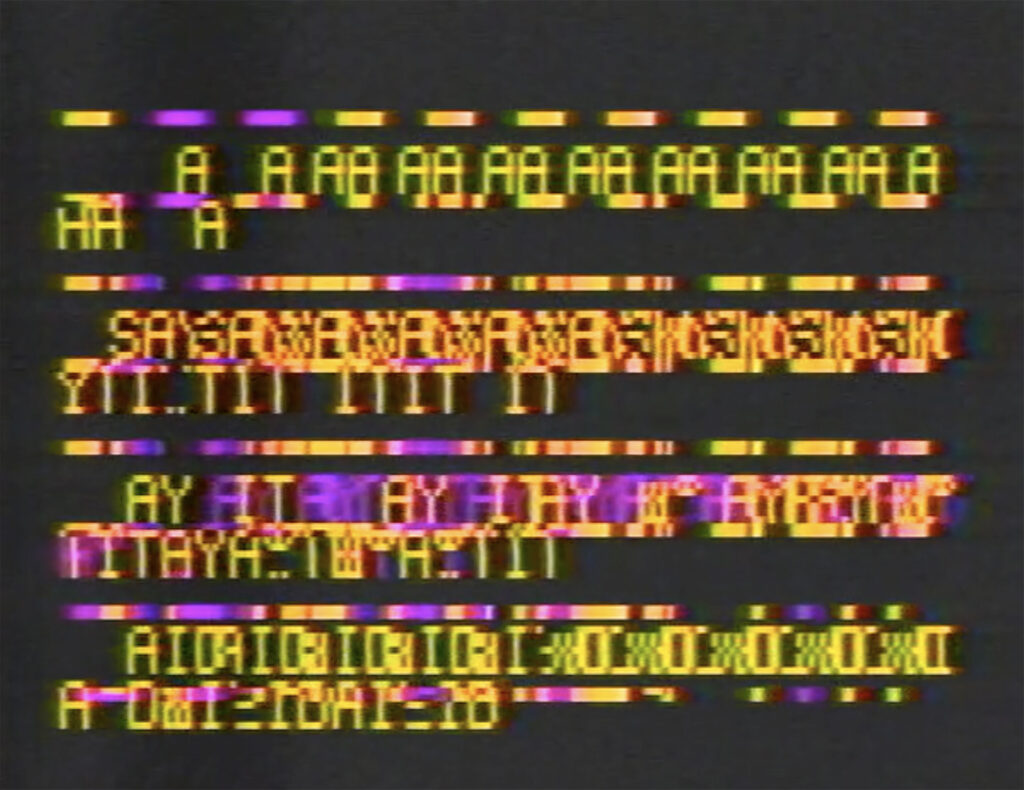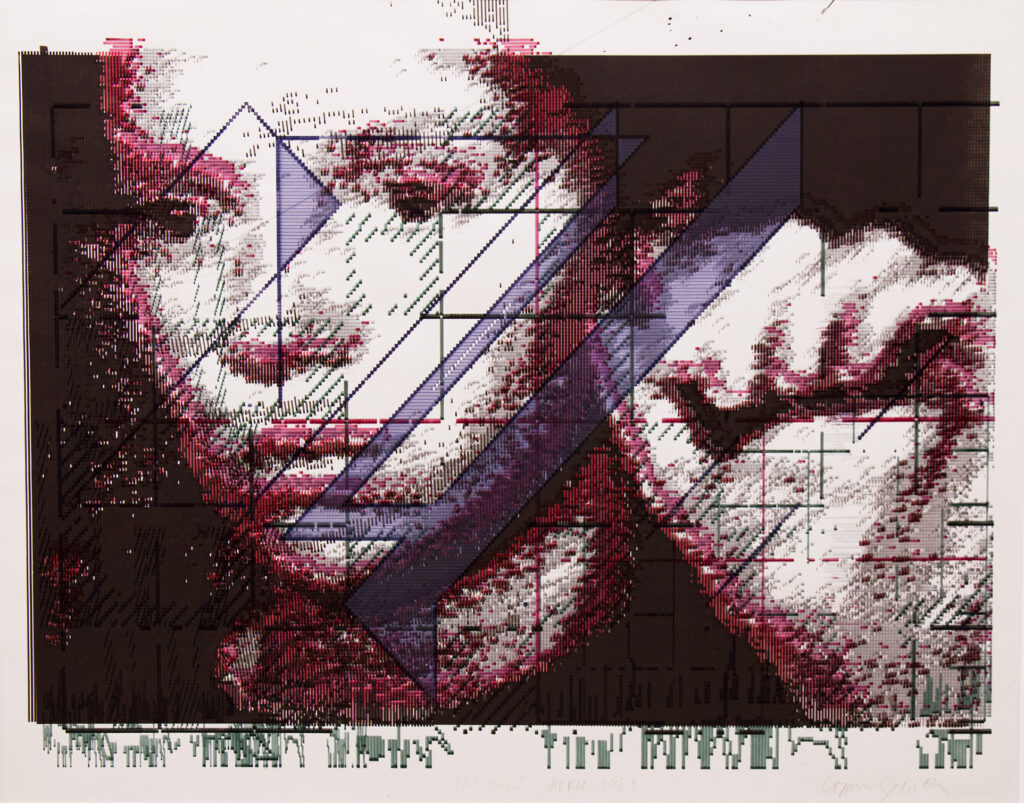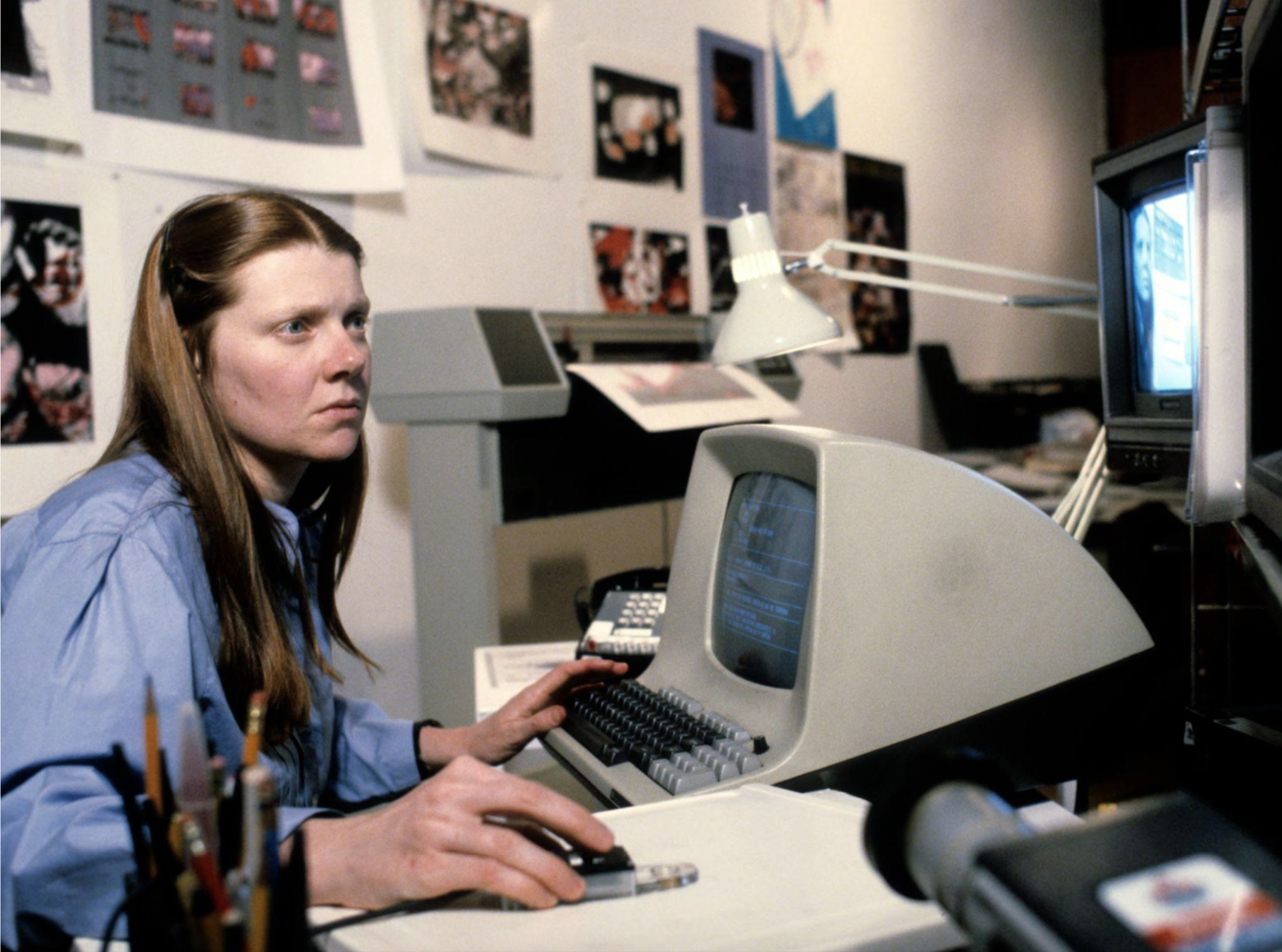Copper Frances Giloth
As I Said
June 5 – July 12, 2025
Curated with Helena Shaskevich
Opening Reception Thursday June 5, 6-8pm

Ultimately, my work lives in the overlap between the intimate and the algorithmic, between feminist storytelling and technological systems. With each piece, I seek to preserve the lived experience, recover silenced narratives, and expand how we imagine memory, identity, and meaning in the digital age.” — Copper Frances Giloth
Microscope is very pleased to present “As I Said,” the first a solo exhibition of works in New York by the groundbreaking computer artist Copper Frances Giloth. The exhibition features early computer-animated videos and drawings from the late 1970s and early1980s by the artist, whose contributions to the development of computer art are receiving renewed attention including as part of the exhibition “Digital Witness: Art and Design: Revolutions in Design, Photography, and Film” currently on view at the Los Angeles County Museum of Art (LACMA).
The exhibition is curated in collaboration with Helena Shaskevich, a scholar specializing in feminist new media from the 1960s to the present, who provides the following background: “Copper Frances Giloth first discovered computers while working as a welder at a Massachusetts shipyard. This transformative experience led her to pursue studies in the burgeoning field of electronic animation and design at the pioneering Electronic Visualization Lab at the University of Illinois Chicago (UIC), where she became part of what critic Christine Tamblyn has referred to as the ‘first generation’ of Chicago new media artists. […] Giloth’s explorations into the relationship between drawing, video, and computer graphics at UIC—where she was first graduate of the MFA program in Electronic Visualization in 1980—played an instrumental role in cultivating the emergence of computer art.”
The exhibition borrows its title from the artist’s 1981 computer animation “As I Said,” which combines Zgrass computer graphics, text, and “errors” caused by digital dropout to address the lack of attention to women’s voices. Emphasizing the feminist themes that first appeared in Giloth’s earlier pieces and have continued to permeate her work for more than forty years, the exhibit features seven computer-animated videos made between 1979 and 1994 and original unique works from her three earliest computer drawings series, which scripted for and drawn by a plotter printer programmed by the artist. Shaskevich says:“By placing Giloth’s videos and plotter prints alongside one another, this exhibition examines the overlapping formal and conceptual strategies in her practice as she shifts between these mediums, including her exploration of the glitch, the line as an elemental, generative form, and the potential painterly effects of a plotter printer.”
During these early years, Giloth worked among a small group of Chicago artists involved with the development and programming of the Zgrass raster graphics computer for their own artistic projects. All but one of the moving image works and drawings in “As I Said” were created on this system, which Giloth further programmed to enable her to draw with a joystick. While these works are registered as videos today, the works were originally actual programs that were saved onto audiocassette tapes. The animations, transitions, and editing were all created with code by the artist, with few exceptions. The Zgrass also had the ability to input and mix sound and to output the programmed imagery to other mediums and devices, both of which were uncommon at that time.
Arguably Giloth’s best known work on view is “Skippy Peanut Butter Jars” (1980), a nearly four-minute computer animation that aired on PBS that same year, and was presented at the Museum of Modern Art (MoMA) in 1982. The work takes the form of an autobiographical narration that tells the story of Giloth’s decision as a young girl to become an artist, leading her to drawing female nudes in secret, as that was what she thought artist’s were required to do. We hear Giloth’s voice reciting two retellings of the humorous story in the stereo soundtrack, while drawings of a nude woman take shape and multiply across the screen, leading up to the work’s surprising ending.
The other videos in “As I Said” are bookended in time and approach between Giloth’s first computer work “Ballyoids Cardioids” (1979), which was made on the Zgrass-32, and her 1994 “Modeling the Female Body: A Survey of Computer-Generated Women 1980-93,” that was composed with jarring appropriated footage of animated women that appeared in videos reviewed by the international computer graphics association ACM Siggraph during that timespan. The former builds upon Giloth’s excitement for the Zgrass machine and her break with vector-based graphics (Grass), and it is the only digital work of hers to incorporate analog video synthesizing processes, while the latter is a manifestation of her continued disappointment with the representation of women in the digital realm.
The plotter drawings are selections from three of Giloth’s earliest series: “DES Series” (1980-81), “LIS Series” (1980-83), and “Wisconsin Series” (1983-84). Shaskevich says of Giloth’s process: “Around 1980 Copper began working with the Zgrass UV-1 (as opposed to the ZGrass-32, which she used for earlier work). She connected this new configuration to a plotter and often refers to the prints from this period as an extension of her digital animation practice. She was interested in making the pen plotter work like a video scan and so developed her own paint/draw/animation system, which interrogated the raster image, drawing from left to right like a video scan (unlike the X,Y Cartesian coordinates typically utilized for plotter prints).”
These works range from brightly-colored, grid-like patterned compositions to multi-layered self-portraits that incorporate black & white video of the artist integrated into nature and her surroundings. The variety of colors and textures are achieved through repeated printings and the mixing of the archival ink colors by hand. Shaskevich adds: “[Copper Frances Giloth’s] plotter prints explore the textures of informational media technologies, … while their rhythmic forms emerge from the inputs and commands of the programming language.”
“As I Said” opens on June 5th and continues through July 12th, with an opening reception on Thursday June 5th, from 6-8pm. Gallery Hours: Tuesdays-Saturdays 12-6pm. For additional information, please contact that gallery at inquiries@microscopegallery.com or by phone at 347.925.1433.
_
Copper Frances Giloth is an award-winning digital media artist whose work has been featured in international festivals, galleries, and museums, including the Los Angeles County Museum of Art (LACMA); the Museum of Modern Art in New York (MoMA); the National Academy of Sciences in Washington, D.C.; the Museum of Contemporary Art Chicago (MCA); and ACM SIGGRAPH. In 1980, Giloth became the first master of fine arts candidate and woman to graduate from the Electronic Visualization Laboratory at the University of Illinois at Chicago. In 1982, Giloth chaired the first ACM SIGGRAPH juried public exhibition of experimental two-dimensional, three-dimensional interactive, and time-based works by artists and scientists. In 1985, Giloth and Jane Veeder co-authored “The Paint Problem,” an influential essay on issues around the future of artists’ digital tools. Giloth is Professor Emeritus of Art at the University of Massachusetts Amherst, where she also served as Director of Academic Computing in the Office of Information Technologies for 21 years.
Helena Shaskevich is Assistant Professor of Art History at Kennesaw State University, where she specializes in feminist new media from the 1960s to the present. She is currently working on two book projects. The first book argues that video art played a central role in the emergence of a broader field of feminist visual politics in the 1970s; the second examines discourses of atomic anxiety and ecological collapse in gaming and computer art during the 1980s. Her writing has been published in Feminist Media Histories, Camera Obscura, Art Journal, Woman’s Art Journal, Millennium Film Journal, Afterimage and the Brooklyn Rail. She has curated numerous public programs on new media art and her most recent curatorial project titled Acid Rhythms, showcased feminist computer art at the Kunsthall Trondheim.


